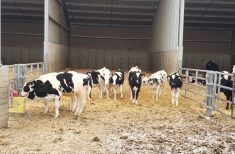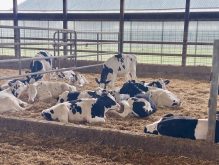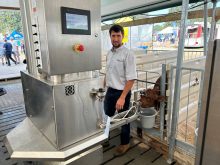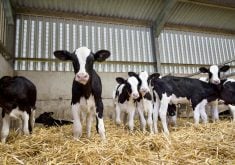For cattle farmers who see a spike in calf mortality but not the typical diarrhea that accompanies common bacterial infections, Quebec-based veterinarian Dr. Frédéric Beaulac says Salmonella Dublin should be top of mind.
And if there is an outbreak, it could be a long road to recovery for the farm.
Why it matters: Salmonella Dublin typically causes chronic health issues for calves that survive and can be transmitted easily from barn to house.
Read Also

Improving calf health, fighting pesticide resistance highlighted at Canada’s Outdoor Farm Show
New strides in agricultural innovation including improving calf health, fighting pesticide resistance were the featured topic at the University of Guelph Feeding The Future discussion at Canada’s Outdoor Farm Show 2025.
Beaulac, who works with veal operations in Eastern Ontario and Quebec, spoke about managing S. Dublin at the recent 2022 Healthy Calf Conference in Stratford hosted by Veal Farmers of Ontario.
Ontario Ministry of Agriculture, Food and Rural Affairs specialist Dr. Cynthia Miltenburg gave an update on the status of the illness, which is still classified as an emerging disease in Ontario after first being detected in imported cattle in 2012 and then appearing in a resident herd in 2014.
Early in his career, Beaulac said he never heard of S. Dublin. But after the disease crossed the U.S. border into Quebec in 2011, he started to see something during calf necropsies: yellowing of the organ fat and heart muscle. Now if he sees this, he’s “99 per cent certain” of the culprit.
The best way to diagnose is through necropsy.
“Feces is not a good way to find Dublin. One time out of two, the Dublin will be present but often it will return a false negative.”
In live calves, high fever and depression are the most common signs. There’s often a slow transmission from calf to calf at the beginning so observant producers can catch it early.
“Two ears down, for me, really is a trigger to think about Salmonella,” he said, referring to a common sign of fever.
Once it gets going, the disease takes an entirely different trajectory than more common strains.
“It’s very well-adapted to bovine species,” Beaulac said. It can cause rapid septicemia by getting into the bloodstream. Clinical signs might indicate some other condition and diarrhea isn’t common.
Typically it strikes calves at 30 to 60 days old, with rare sporadic cases at 20 days old or less. In Quebec, approximately 10 per cent of dairy farms are positive for S. Dublin, Beaulac said.
“And Dublin is a killer. If you have high mortality, always think about Dublin.”
A chronic form can also appear if the animal survives.
“If you’re just 24 hours late to treat that animal, there will be so much damage that they will go on to become chronic sufferers if they survive … (The calf) will never be able to gain weight or follow the rest of the group.”
Miltenburg said that since 2012, S. Dublin has been detected on nearly 80 premises in Ontario. A 2020 map showed most Ontario cases in the southwest, reflecting a shift from mainly veal facilities into more dairy farms. The symptoms are typically septicemia (fever and depression) and continual pneumonia.
In other areas, including parts of Europe, she said abortion is a more common presentation of outbreaks. Here, it has generally been calves both pre- and post-weaning.
There is a consistent pattern of multi-drug resistance, and this is true also with the related cases that have shown up in humans.
“Salmonella as a bug is very good at acquiring drug resistance,” Miltenburg said.
Work done last summer on 100 Ontario dairy farms revealed 24 had a positive case. In addition, a David Kelton-led project for bulk tank milk testing for all Ontario dairy farms in 2022, continuing this year, showed some farms have it but don’t know it.
Since the disease emerged in Quebec, Beaulac has done bacteriology on almost all cases he has seen, with an aim to determine which antimicrobials are effective.
Of the effective treatments he has found, one is not allowed in bovine species in Canada, and two don’t have injectable forms that make them practical for calves. However, there are a few options.
He suggested using antimicrobial treatments of a week or more, rather than just the three to five days typically outlined on product labels. Using the right antimicrobial might not be enough for the calf if it’s already affected, he added, but it should slow transmission in the barn.
Two vaccines against S. Dublin are available in Canada. One is labelled for bovine but targets S. Newport, with some cross-protection against S. Dublin. The other is labelled for swine but Beaulac uses it off-label in cattle.
The swine vaccine isn’t entirely effective but he believes the scale of outbreaks is decreased. However it’s a live vaccine, so he cautions producers to be careful in its use. The oral treatment can make calves sick, so producers must be careful with dosage and be ready to use other treatments.
The vaccine labelled for cattle is expensive in a veal context, though it might make sense for dairy, he said. Beaulac trialled a lower dose to make it more affordable but there was insufficient protection.
Producers should also vaccinate for bovine viral diarrhea. When Beaulac started seeing cases, tested samples indicated BVD was present in roughly half. S. Dublin is an immune suppressor, he explained, so
“if you have a carrier of Dublin, watch out. It could be the second problem you have on your farm.”
Transmission is oral, so all-in, all-out management is preferred. Adhere to strict hygiene protocols for everything that goes in a calf’s mouth, he advised.
Instead of cleaning nipples, bottles and buckets, consider buying more. Have one nipple per calf and keep water bowls clean.
Blood-to-blood transmission is less likely but still possible so watch needle management, he said.
Miltenburg added that, “when people get this disease, it can cause a very severe infection” and lead to hospitalization and even death. S. Dublin persists on boots for 48 hours if they’re just rinsed with water, and survives for months in more favourable environments. There’s also an infection risk with raw milk.
“If you know your herd is Dublin-unstable, please act accordingly,” Beaulac concluded. One sick animal mixed with 99 healthy ones “can create huge chaos.”













